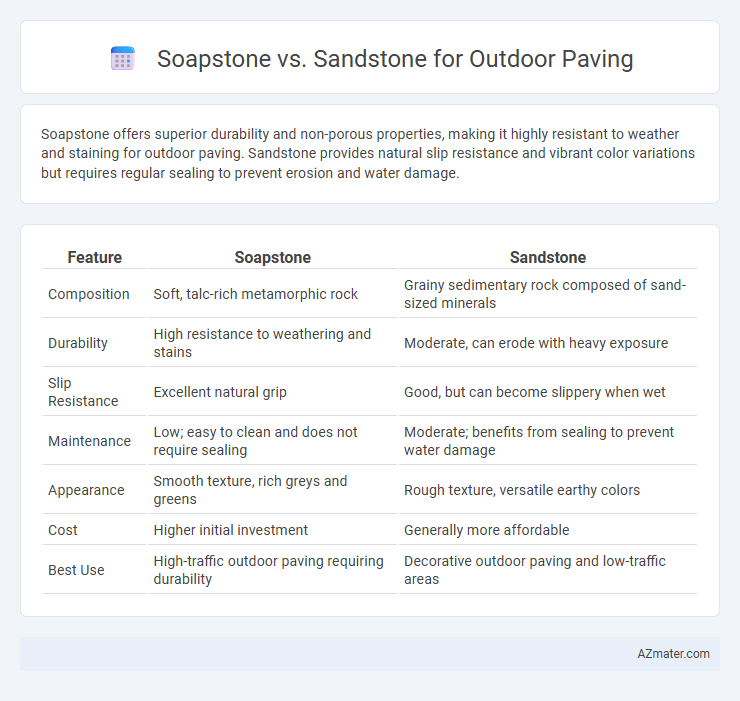Soapstone offers superior durability and non-porous properties, making it highly resistant to weather and staining for outdoor paving. Sandstone provides natural slip resistance and vibrant color variations but requires regular sealing to prevent erosion and water damage.
Table of Comparison
| Feature | Soapstone | Sandstone |
|---|---|---|
| Composition | Soft, talc-rich metamorphic rock | Grainy sedimentary rock composed of sand-sized minerals |
| Durability | High resistance to weathering and stains | Moderate, can erode with heavy exposure |
| Slip Resistance | Excellent natural grip | Good, but can become slippery when wet |
| Maintenance | Low; easy to clean and does not require sealing | Moderate; benefits from sealing to prevent water damage |
| Appearance | Smooth texture, rich greys and greens | Rough texture, versatile earthy colors |
| Cost | Higher initial investment | Generally more affordable |
| Best Use | High-traffic outdoor paving requiring durability | Decorative outdoor paving and low-traffic areas |
Introduction to Soapstone and Sandstone
Soapstone and sandstone are popular natural stones used for outdoor paving, valued for their durability and unique textures. Soapstone is a metamorphic rock composed primarily of talc, offering a smooth, soapy feel with excellent heat resistance and non-porous properties that prevent water absorption. Sandstone, a sedimentary rock formed from cemented sand grains, features a gritty texture and varied color spectrum, known for its strength and slip resistance ideal for outdoor environments.
Physical Properties Comparison
Soapstone features a dense, non-porous structure with high resistance to water absorption and excellent durability against weathering, making it ideal for outdoor paving. Sandstone, characterized by its granular texture and higher porosity, tends to absorb more moisture, which can lead to erosion and surface wear over time. The hardness of soapstone, typically around 1 to 2.5 on the Mohs scale, provides moderate scratch resistance, while sandstone varies widely but is generally softer, requiring more maintenance in outdoor environments.
Durability and Weather Resistance
Soapstone offers excellent durability and superior weather resistance for outdoor paving, with its dense, non-porous nature making it resistant to water, frost, and chemical damage. Sandstone, while attractive and available in various colors, is more porous and prone to erosion, staining, and weathering over time when exposed to harsh outdoor conditions. Choosing soapstone ensures a longer-lasting, low-maintenance surface ideal for enduring severe weather, whereas sandstone requires regular sealing and maintenance to preserve its appearance and structural integrity.
Slip Resistance and Safety
Soapstone offers superior slip resistance due to its naturally smooth yet non-slip surface, making it a safer choice for outdoor paving in wet conditions. Sandstone, while aesthetically appealing with its textured finish, can become slippery when wet, increasing slip hazards. For outdoor areas requiring high safety standards, soapstone's durability and grip provide enhanced protection against falls.
Maintenance Requirements
Soapstone requires minimal maintenance for outdoor paving, as its dense, non-porous nature resists moisture and stains, needing only occasional cleaning with mild soap and water. Sandstone, being more porous, demands regular sealing and more frequent cleaning to prevent water absorption, staining, and erosion caused by weather exposure. The natural durability of soapstone makes it a more low-maintenance choice compared to sandstone in outdoor environments.
Aesthetic Appeal and Color Options
Soapstone offers a smooth, matte finish with subtle veining, providing a sophisticated and timeless aesthetic for outdoor paving. Sandstone displays a broader range of earth tones, including warm reds, yellows, and browns, creating a rustic and natural look ideal for diverse landscape designs. The color stability of soapstone resists fading over time, while sandstone's vibrant hues may mellow with weather exposure, influencing long-term visual appeal.
Installation Process and Techniques
Soapstone for outdoor paving features a dense, non-porous surface that allows easier cutting and shaping with standard masonry tools, enabling precise fitting and smooth installation. Sandstone requires careful handling due to its porous nature and layered composition, often necessitating sealing before installation to prevent moisture damage and specialized cutting techniques to avoid chipping. Both materials demand proper base preparation and leveling, but soapstone's durability and ease of maintenance offer a more straightforward long-term paving solution.
Cost Comparison: Soapstone vs Sandstone
Soapstone typically costs between $15 and $30 per square foot, making it a more expensive option for outdoor paving compared to sandstone, which ranges from $5 to $15 per square foot. The higher price of soapstone reflects its durability and resistance to weathering, whereas sandstone's affordability suits larger budget projects despite potential maintenance costs. Choosing between soapstone and sandstone involves balancing initial investment against long-term value and performance in outdoor settings.
Best Applications for Each Stone
Soapstone's dense, non-porous nature makes it ideal for outdoor paving in areas exposed to moisture and temperature fluctuations, providing excellent resistance to weathering and slip hazards. Sandstone's porous texture and natural roughness offer superior traction, making it well-suited for garden pathways and patios where aesthetic appeal and drainage are priorities. Choosing soapstone ensures durability and low maintenance in wet climates, while sandstone enhances outdoor spaces with its natural slip resistance and visual warmth.
Conclusion: Choosing the Right Stone for Your Outdoor Space
Soapstone offers superior durability and resistance to weathering, making it ideal for outdoor paving in harsh climates, while sandstone provides a natural, textured aesthetic with excellent slip resistance. For high-traffic areas requiring long-lasting performance, soapstone's density and minimal porosity ensure longevity, whereas sandstone suits decorative projects emphasizing natural beauty over extreme durability. Assess environmental conditions and design goals carefully to select the stone that balances functionality and visual appeal in your outdoor space.

Infographic: Soapstone vs Sandstone for Outdoor Paving
 azmater.com
azmater.com